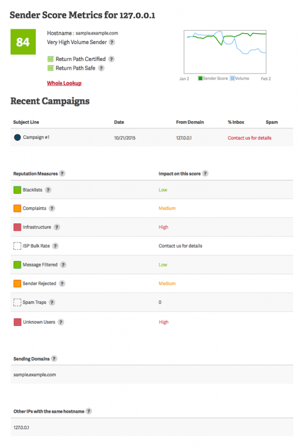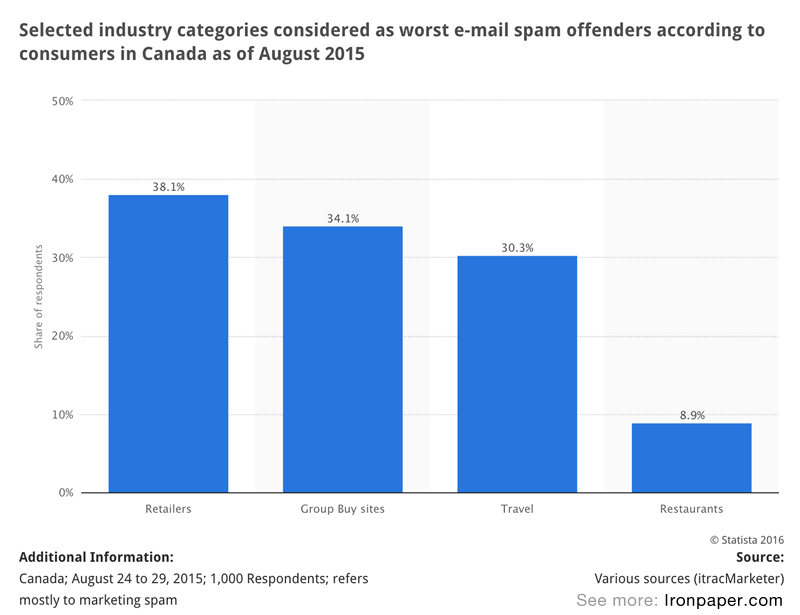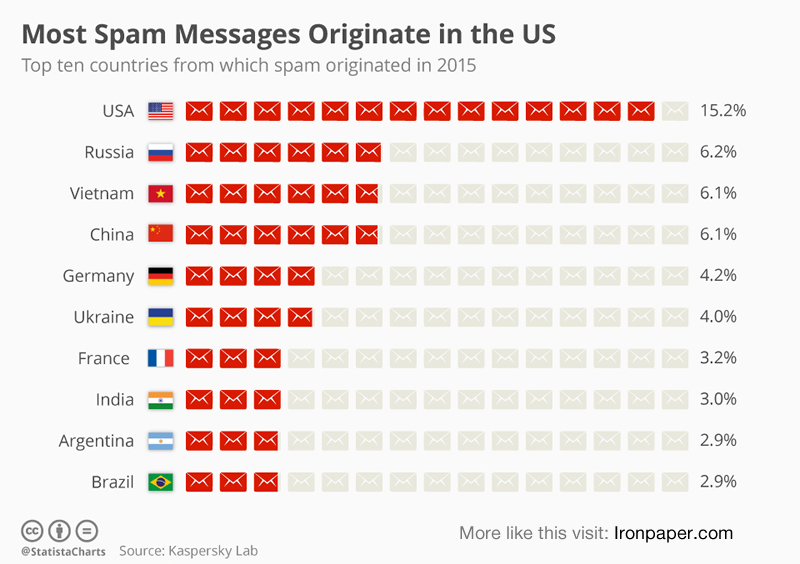
 Earning customers is a challenge in every industry. But marketers make their job even more difficult when they purchase names and send unsolicited promotional communications. By purchasing email lists and sending unsolicited emails (spam), you are putting your business in a league with some truly undesirable company.
Earning customers is a challenge in every industry. But marketers make their job even more difficult when they purchase names and send unsolicited promotional communications. By purchasing email lists and sending unsolicited emails (spam), you are putting your business in a league with some truly undesirable company.
Before addressing best practices to try instead, let’s first examine why buying lists will kill future sales.
83% of the time, if your email isn’t arriving at its destination, it’s due to poor reputation with ISPs. --Unbounce
First, how do you feel about receiving a cold call? Unless you're eager to exchange pleasantries with a stranger while preparing a meal or trying to corral kids into the car for a sporting event, it's likely you aren't happy about it. No one is. Enough said.
Then, there are those who buy email lists.
There’s no such thing as an opt-in list for sale! –Madmimi
It’s already hard enough to get someone to open an email and take an action, but you need to get into the inbox first. Sending email that is unwanted, and doesn’t have value for the recipient, will end up with the company’s messages being marked as spam, or worse--blacklisted. The company's email deliverability overall — a measure of how effective the marketer is at getting their message into the recipients’ inbox — will suffer.
43% of email recipients click the spam button based on the “from” name or email address, so it’s important that email recipients know who you are and expect to receive emails from you. -- Unbounce
When that happens, all the work the company did to develop a great product, come out with target audiences, create marketing content, and design and develop the optimal user experience is for nought if the marketing message doesn’t get into the inbox.
“Poor deliverability is like an infection.” — HubSpot postmaster Tom Monaghan
Related reading: What is an email sender score?

Past performance of email will also influence the company’s future results. A company with a poor reputation with email clients, also known as an email sender score, could even see emails to people that do want the communication getting shuffled into spam or bulk folders. Sending spam email can also deride the value of an industry--harming open rates and deliverability for categories of business.

“Email is a long game. Your brand is worth it. Don’t throw it away chasing the promise of easy customers. They don’t exist.” — HubSpot postmaster Tom Monaghan

It’s easy enough to imagine the reactions of an individual receiving a communication he or she doesn’t care about — unless, somehow, that has never happened to you. So, why do it? Contacting people who have not asked to hear from your organization can spoil their perception of your organization. The goal is to help foster customer trust and build your company’s authority — being a spammer is not the way tor reach that goal.
Related reading: Buying leads versus inbound leads — which works better?
Inbound marketers communicate with people who willingly provide their information. Once the company gets an email address from someone via an online form or newsletter subscription or trade show visit they follow-up strategically. Let’s summarize some of the top tactics to consider:
Segment — Delivering messages to the right people, at the right time, in the right context is central to permission-based marketing. Use data-driven analysis to distinguish segments of audience based on who they are and where they are in their journey. You can use explicit (the information they willingly share) and implicit data (information gleaned about their behavior, engagement and interests often from marketing automation tools, social media scans and past practices) to make smart segments.
Consider primary goal — Inbound marketing understands the consumer has the power; the marketer’s role is to provide helpful, relevant content that adds value. With this in mind, the marketer needs to determine, in advance, the primary goal of their communications. Develop a content plan in which communications address the different audiences in targeted ways that incite recipients to the desired action.
Focus on one CTA — Too many choices can paralyze the message recipient and prompt them to opt out of taking any action at all. Having determined the primary action goal, the marketer can focus the communication on just one call-to-action (CTA) by having CTA buttons and internal links driving traffic to the same targeted action.
Design for best user experience — Consider both what is being said and how it looks. Reducing information density and incorporating white space can better accommodate those encountering the messaging on mobile devices. Whether it is email or a landing page, be deliberate about the top 25% of the page — use headers, subheads, bulleted text and more to enable scanning that quickly establishes value and importance of the message.
Measure engagement and list churn — The good and the bad both matter. Yes, it helps to see what prompts someone to engage. At the same time contact churn metrics such as unsubscribes, bounce rates and spam complaints can also be telling about the efficacy of communications to even get into the inbox.
Related reading: Where to get B2B sales leads
Ultimately, the inbound marketer understands closing the sale can’t be the only objective. They know buying lists will kill future sales. A big part of this strategy is continuing to delight customers with personalized content, new product recommendations, emails tailored to their interests, and interactions on social media to ensure they remain satisfied with and impressed by your brand for the long-term.
Why buying lists will kill future sales Sources:
HubSpot. (n.d.). How to take control of your deliverability. https://academy.hubspot.com/emc16/the-essentials-of-email-deliverability
Unbounce, Abigail Waterer, August 11th, 2014 5 Email Marketing Mistakes That Are Killing Your Open Rates, https://unbounce.com/email-marketing/5-mistakes-that-kill-open-rates/
by Jonathan Franchell, CEO of Ironpaper - For more tips and hacks: Need to remove a new line after h1 tags? Both web designers and SEO practitioners need to employ headline tags: H1, H2, H3 in several ways to improve web page structure and tag...

The Crowded Arena of the IT Marketplace Updated December 2024 The Information Technology (IT) landscape is experiencing rapid growth and intensifying competition. IT spending is projected to reach nearly 5.1 trillion U.S. dollars in 2024, a...

Updated December, 2024 The field of digital marketing is evolving rapidly in response to new technology and changing buyer expectations. To help career-minded marketers, we’ve rounded up the top 10 skills needed to succeed in the field. These are...

The marketing industry is transforming significantly due to generative AI and increasing market complexity. Gartner's prediction of a 25% decline in traditional search traffic suggests that the era of search engines is dying. AI tools, particularly...
